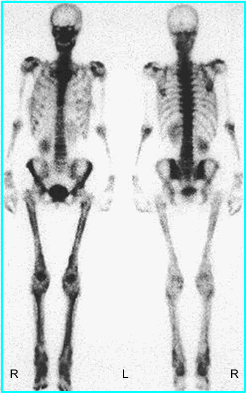

Hypertrophic Pulmonary Osteoarthropathy is usually associated with some type of underlining pulmonary disease, usually certain types of lung cancer, especially non-small cell lung carcinoma. It usually shows increased uptake in the cortical long bone, phalanges, scapula, and clavicle. Focal uptake can also be noted throughout the peripheral appendages, as well as intense uptake in the central skeleton. In the case presented, the patient had bronchial carcinoma. Images obtained from The Royal College of Surgeons of Edinburgh. The link no longer active.
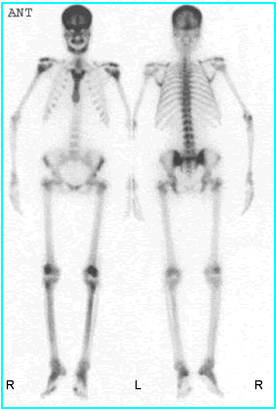
Hyperparathyroidism presents itself with a "high-quality" bone scan. There is intense uptake in the peripheral skeletal areas of the body, lack of renal uptake (why is that), and may even show uptake in the lung, stomach, and other soft tissues. Images obtained from The Royal College of Surgeons of Edinburgh - link is no longer active and has been removed.
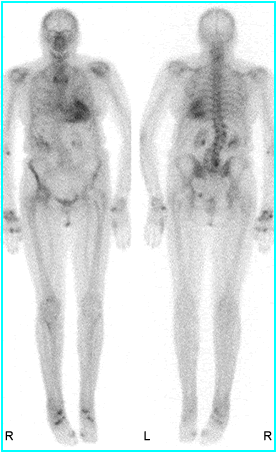
Prior to the bone scan, the patient had complained of some chest pain several days ago, however, it went away. What does the bone scan reveal?
This study from Royal United Hospital Bath and is no longer active. http://www.ruh.nhs.uk/
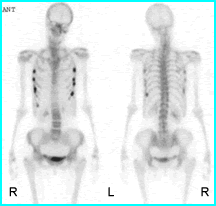
The history on this patient is the complaint of chest pain after falling. What does the bone scan reveal? The link to this study from Roayl United Hospital Bath is no longer active. http://www.ruh.nhs.uk/
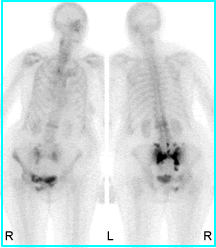
What is causing all the hot spots in the lower back? Is there an issue going on with the lower spine? Your thoughts? What can happen to a patient's bones that become osteoperotic?
The link to this study from Royal United Hospital Bath is no longer active. http://www.ruh.nhs.uk/
Consider the above images and discuss what is abnormal about this whole-body procedure. What is the disease?
http://www.e-radiography.net/radpath/p/pagets.htm (link no longer active)
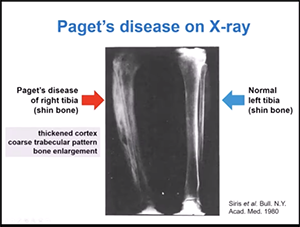
Here is an example of what Paget's looks like in an x-ray. Notice the buildup of bone on the affected side
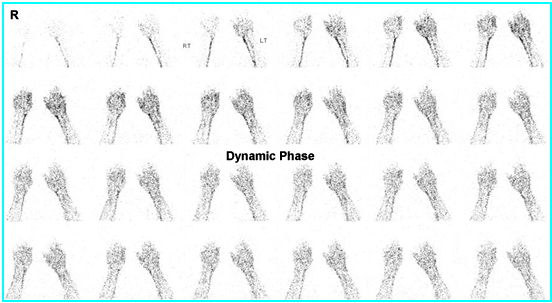
Following cocaine use and exposure to the elements (-3oF), the patient arrived in the ER with swollen fingers. The following three-phase bone scan was completed.
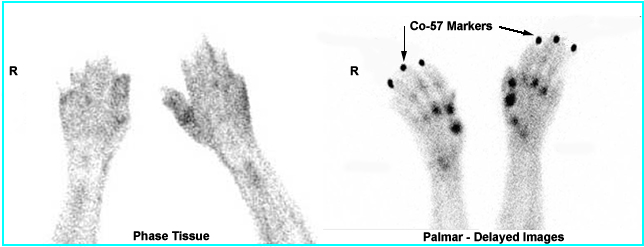
On the delayed images Co-57 marker is placed 2nd through 4th digits bilaterally. What can you conclude from this data? http://www.med.harvard.edu/JPNM/TF03_04/Jan11/WriteUp.html
99mTc bone scan shows a lack of uptake caused by a lytic bone tumor to the distal radius. Unrelated to this tumor was a long-standing vascular access graft in the same forearm which was needed for renal dialysis. The lesion was shown to be a sarcoma.http://emedicine.medscape.com/article/378801-imaging
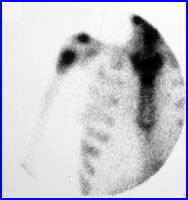
The left SI joint has increased uptake which, is due to chondromyxoid fibroma. ROIs could be drawn on both sides to determine the SI ratio. emedicine.medscape.com/article/388738-imaging
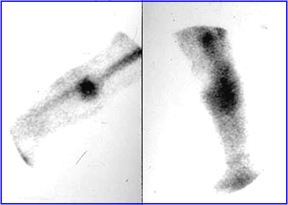
http://www.skeletalscintigraphy.com/fp/softtissueother.htm (it appears that this link is not working)
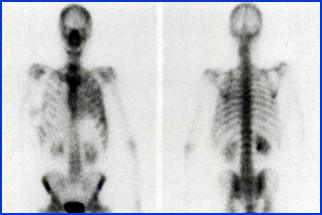
Metastatic disease can manifest itself in the thorax or abdominal cavity and is referred to as pleura metastasis. The article also shows an example of abdominal and renal areas with pleural effusion.
http://jnm.snmjournals.org/content/35/3/429.full.pdf
Six months post hip replacement, a 3-ph a WBCs scan are completed on a 76 yr. old patient to evaluate infection. What do you think? Is it infection or loosening?
http://herkules.oulu.fi/isbn9514272315/html/x1343.html
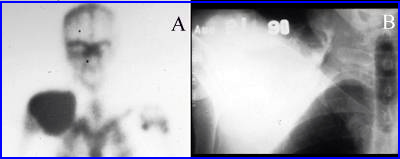
Defined as metastatic calcification. The actual type of cancer is not stated.
http://www.skeletalscintigraphy.com/fp/softtissueother.htm
While this is not a bone scan, this FDG PET study it gives us an example of what a Pancoast tumor would look like. These tumors arise from the pulmonary apex. Most tumors of this type are non-small cells, and they usually reside over the right or left apex of the lung, making this one just a little more unusual.
http://pet-ct-kpc.blogspot.com/2014/01/huge-apical-lung-cancer-pancoast-tumor.html?view=timeslide
This type of uptake is referred to as a superscan, where the majority of the injected MDP is absorbed by the bone matrix. This occurs with some widespread metastatic disease that originate from the prostate. Some superscans have no renal or urinary bladder uptake.
http://www.rad.kumc.edu/nucmed/clinical/super.htm
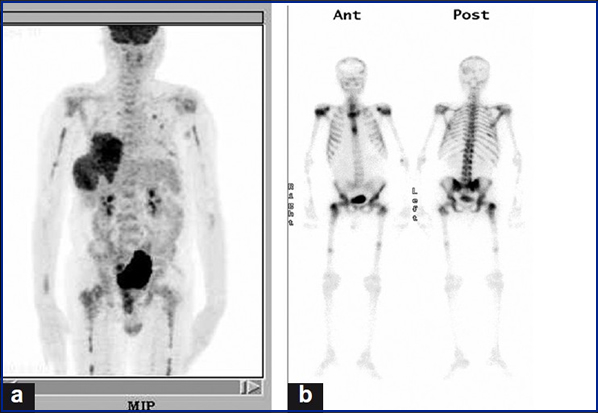
On the left is an FDG PET scan and on the right is the same patient with a bone scan. The patient has prostate cancer. PET is not generally used to image the prostate, but abnormal uptake can be noted on both scans.
http://www.indianjcancer.com/viewimage.asp?img=IndianJournalofCancer_2010_47_4_385_73572_u5.jpg
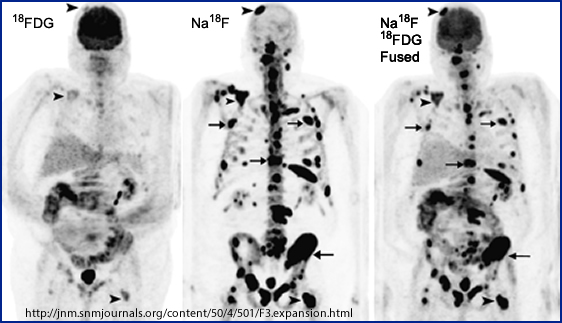
A 25-year -old male with leg pain caused by exercise. The term "shin splints" has been replaced with Medial Tibial Stress Syndrome (MTSS). Excessive muscle stimulation to the cortical bone has caused periostitits, which can eventually lead to a stress fraction.
Following an excessive amount of "running" and a slower pace was notice on track, there appeared a spot on the Bone Scan. Your comments?
http://www.bwfurlongnj.com/services.html
http://radiographics.rsnajnls.org/cgi/content/full/23/2/341
Return to the Table of Content